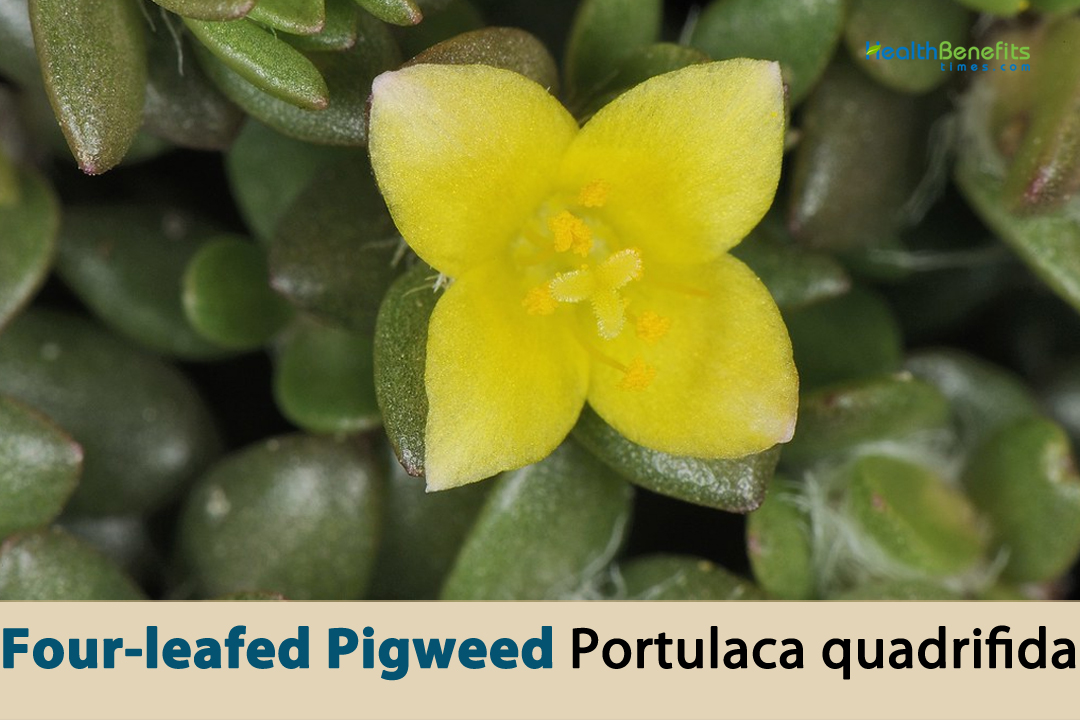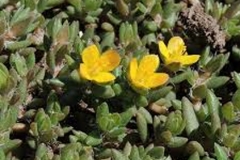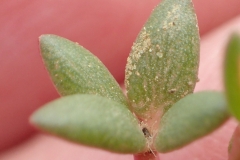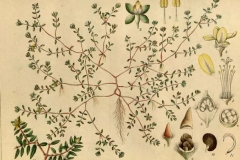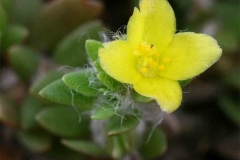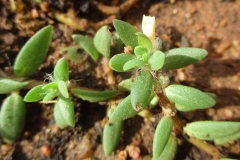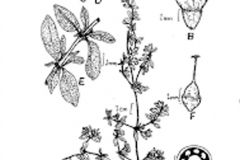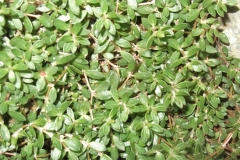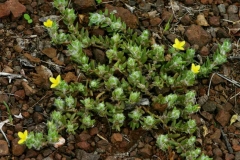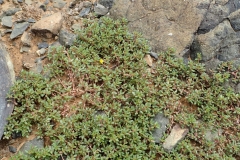| Four-leafed Pigweed Quick Facts | |
|---|---|
| Name: | Four-leafed Pigweed |
| Scientific Name: | Portulaca quadrifida |
| Origin | Tropical Africa, the Arabian Peninsula, India and South East Asia |
| Colors | Initially green turning brown as they mature |
| Shapes | Small, rounded capsules around 3 to 5 millimeters in diameter |
| Taste | Slightly sour or tangy, with a hint of saltiness |
| Health benefits | Beneficial for asthma, cough, rheumatism, urinary discharges, inflammations, ulcers, erysipelas, hemorrhoids, abdominal complaints |
| Name | Four-leafed Pigweed |
|---|---|
| Scientific Name | Portulaca quadrifida |
| Native | Tropical Africa, the Arabian Peninsula, India and South East Asia |
| Common Names | Four-leafed Pigweed, Chickenweed, Purslane-leaved Pigweed, Broadleaf Portulaca, Four-leafed Portulaca, Wild Purslane, Red Pigweed, Alligator weed, Garden Purslane, Summer Purslane, common Purslane, Moss Rose, Yellow Pigweed, Green Purslane, Herb Purslane, Pusley, Garden Purslane, Little Hogweed, Big leaf Portulaca, Wild Portulaca, Indian Purslane, Duckweed, Nootropic Purslane, Fleshy Portulaca, Water Portulaca |
| Name in Other Languages | Afrikaans: Dwerg porselein, Rooi porselein Arabic: Al-baqlah al-raba’iyyah al-awraq (البقلة الرباعية الأوراق) Assamese: Bilahemi shak (বিলাহেমি শাক) Bengali: Char pata biguna (চার পাতা বিগুন), chota-nunya Burmese: Mya-byit, Mya-byit-gale Chinese: Sì yè zhū cǎo (四叶猪草), Si lie ma chi xian (四裂马齿苋), Si ban ma chi xian (四瓣马齿苋), Xiǎo mǎ chǐ xiàn (小马齿苋) Cuba: Espinaca, verdolaga Danish: Firebladet Portulak Dominican Republic: Pinganilla, regina, ringa Dutch: Vierbladig varkenskruid English: Four-leafed Pigweed, Chickenweed, single-flowered Purslane, small-leaved Purslane, ten o’clock plant, wild Purslane, chickenweed Purslane, pusley Finnish: Nelilehtimaitikka French: Pourpier à quatre feuilles, pourpier, poupyé doub, pourpier marron German: Vierblättriges Portulakröschen Gujarati: Chāra pattāmvāḷī utāṇ (ચાર પત્તાંવાળી ઉતાણ) Hindi: Chaara patti khudraai (चार पत्ती खुदराई), chaunlayi, chotaluniya, godupavili kura, pacin, passalai keerai, pavin sinna paruppu keerai, paviri Indonesian: Rumput Ayam Irula: Pulikkeerai Italian: Porcellana a quattro foglie, Portulaca a quattro foglie Japanese: Yotsuyubi aoi (ヨツユビアオイ) Kannada: (Nālku ele pigvīḍ (ನಾಲ್ಕು ಎಲೆ ಪಿಗ್ವೀಡ್), Goli soppu (ಗೋಳಿಸೊಪ್ಪು), Goni soppu (ಗೋಣಿಸೊಪ್ಪು), Haalibacchele (ಹಾಲಿಬಚ್ಚೆಲೆ), Biliya garuke (ಬಿಳಿಯಗಱುಕೆ) Kinyarwanda: Urutenga Konkani: Chaara pānānchī bhājī (चार पानांची भाजी) Korean: Ne-ip huindeowipul (네잎 흰더위풀) Lesser Antilles: Pourpier double Malayalam: Nāl ila (നാല് ഇല) Marathi: Chaara pānānchī khudgaḷ (चार पानांची खुडगळ) Myanmar: Mya-byit-galenya-byit Nepali: Chaara pātakō taka (चार पातको ताक) Norwegian: Firkloverpiggress Odia: Chaara paata shaaka (ଚାର ପାତ ଶାକ) Pakistan: Lunak Philippines: Sayikan Portuguese: Beldroega, Beldroega de Folhas Largas Puerto Rico: Yerba de pollo Punjabi: Chāra patē vālī tarkarī (ਚਾਰ ਪੱਤੇ ਵਾਲੀ ਤਰਕਰੀ) Russian: Chetyrekhlistnaya portulaka (Четырехлистная портулака) Sanskrit: Paciri, Paviri, Laghulonina, Uppadyki Spanish: Verdolaga, Verdolaga Grande, Verdolaga Roja, hierba de pollo Swedish: Fyrlövigt griskärs Tamil: Nānk u ilaikaḷuṭaṉ pūccicceṭi (நான்கு இலைகளுடன் பூச்சிச்செடி), Chinnaparuppukirai, Sirupasalai, Siru pasalai, Taraipsalai, Tharai pasalai, Pasalai keerai (பசலை கீறை) Telugu: Nālugu ākulatō gubbalu (నాలుగు ఆకులతో గుబ్బలు), Goddu pavelli Thai: Phak bia nu Urdu: Chaār patē vālā bēl (چار پتے والا بیل) |
| Plant Growth Habit | Slender, prostrate, mat-forming annual or short-lived perennial herb |
| Growing Climates | Gardens, farms, open fields, roadsides, rocky or sandy areas, tropical and subtropical regions, urban environments, sandy river banks, open stony dry, sub-desert grassland and shrub land, Acacia savanna; trampled areas and edges of cultivated fields |
| Soil | Prefers well-draining soils. It can grow in a range of soil types, including sandy, loamy, or rocky soils. It can also tolerate poor soils, such as those with low fertility or high salinity |
| Plant Size | About 10 to 30 centimeters (4 to 12 inches) tall |
| Root | Roots of Four-leaved Pigweed are made up of many fibrous roots that grow out and spread |
| Stem | Cylindrical, thick, solid and succulent. It is pubescent at the level of the nodes (stipular collar). It is usually tinged with purple |
| Leaf | Opposite, borne by a short petiole. The blade is lanceolate, with a rounded to acute apex and a rounded base. It is 3 to 8 mm long and 1 to 3 mm wide. It is thick and succulent |
| Flower | Terminal and solitary. They are sessile, yellow in color and 3 to 5 mm wide. The calyx is composed of 2 broad sepals, whose base is welded to the ovary. The corolla includes 4 free petals. The stamens are 6 to 10. The ovary is surmounted by a style divided into 4 linear stigmas |
| Fruit Shape & Size | Small, rounded capsules that contain the seeds that typically measures around 3 to 5 millimeters in diameter |
| Fruit Color | Initially green turning brown as they mature |
| Seed | Small, usually ranging from 0.5 to 1 millimeter in size. They are typically dark brown or black in color and have a smooth, shiny surface |
| Flavor/Aroma | Mild, grassy or earthy scent |
| Taste | Slightly sour or tangy, with a hint of saltiness |
| Plant Parts Used | Leaves, Stems, Extracts, seeds |
| Propagation | By seeds, stem cuttings, division, self-seeding |
| Lifespan | Within one year |
| Major Nutrition |
|
| Health benefits |
|
Plant Description
Four-leafed Pigweed is a thin, prostrate, mat-forming annual or short-lived perennial grass that grows to a height of 4 to 12 inches when it is fully grown. The plant grows in a way that looks like it is lying down, with its branches spreading out along the ground. Because it grows slowly, it can be used as a ground cover or to grow over the edges of a yard. The plant grows in parks, farms, open fields, roadsides, rocky or sandy areas, tropical and subtropical areas, urban areas, sandy river banks, open stony dry, sub-desert grassland and shrub land, Acacia savanna; trampled areas and edges of cultivated fields. The plant does best in dirt that drains well. It can grow in different kinds of soil, like sandy, loamy, or rocky soil. It can also grow in bad soils, like those that don’t have enough nutrients or are very salty.
Appropriate growing locations of Four-leafed Pigweed
Four-leafed Pigweed is a plant that is well-suited to grow in various regions and under different conditions. Here are some appropriate growing locations for Four-leafed Pigweed:
- Climate: Four-leafed Pigweed grows well in hot and warm places. Usually, it lives in warm and subtropical areas. It can live in dry and semi-dry places and can handle high temperatures.
- Soil: Four-leafed Pigweed likes dirt that drains well. It can grow in different kinds of soil, like sandy, loamy, or rocky soil. It can also grow in bad soils, like those that don’t have enough nutrients or are very salty.
- Sunlight: For Four-leafed Pigweed to grow well, it needs to be in full sun. It grows best in places where there is a lot of direct sunshine, usually at least 6 to 8 hours per day.
- Moisture: Even though Four-leafed Pigweed can survive in dry conditions, it does best when it gets watered often, especially when it is dry. Getting enough water helps plants grow and bloom. But it’s important not to overwater, because the plant’s roots can die if they get too much water.
- Habitat: Four-leafed Pigweed grows in open fields, pastures, disturbed areas, and along roadsides, among other places. It can grow in both wild environments and ones that have been changed by people.
- Geographic Distribution: Four-leafed Pigweed is from South Asia and can be found in India, Bangladesh, Nepal, Sri Lanka, and some parts of Southeast Asia. It can also be found in other warm and subtropical parts of the world.
Roots
The roots of Four-leaved Pigweed are made up of many fibrous roots that grow out and spread. Compared to the thick, coarse, and delicate taproots of some other plant species, these roots are thin, fine, and soft. The roots of Four-leafed Pigweed grow close to the surface of the dirt and spread out horizontally rather than down. People often talk about this kind of root system as a thin fibrous root system.
The roots’ main job is to hold the plant down in the dirt and give it stability and support. Even though Four-leafed Pigweed has shallow roots, the fibrous roots help keep the plant from being easily pulled by wind or other outside forces.
Stem
The stem is herbaceous, which means it is green, soft, and doesn’t have any hard tissue. It is usually tall and thin and can grow up to 10 to 30 centimeters (4 to 12 inches) tall. It grows from the ground up to the sky. Stems are often semi-prostrate, which means they can spread out along the ground or grow up. It grows many stems from a single plant, making it look thick and bushy. It is usually green because it is made of plants. It is smooth and has small grooves or bumps along its length. The stem lets the plant adapt to different growing situations and do well in them. It can handle a wide range of conditions, such as different types of dirt, levels of moisture, and amounts of light.
Bark
Since Four-leafed Pigweed is not a woody plant, it does not have a base. Instead, it has soft, green, herbaceous roots that don’t have a clear bark layer. The stem is mostly made up of non-woody cells that help the plant grow and stay upright.
Leaves
Along the stem, the leaves are grouped in pairs. This means that each leaf comes out of the stem at a different place, not right next to or on top of another leaf. Most of the time, the leaves are spoon-shaped, or spatulate, which means they are wider at the tip and smaller at the base. The shape of the leaf may change a little, but most of the time the tip is round or slightly pointed. They are about 1 to 3 centimeters (0.4 to 1.2 inches) long, which is not very big. The width of the leaves can change, but they are usually between 0.2 and 0.4 inches (0.5 to 1 cm) wide.
Healthy leaves are bright green, which is a sign of how well they are doing. The green color can look different based on things like how much light it gets and how the environment is. The leaves are smooth and thick, which makes them feel very juicy. The smooth surface helps keep water from evaporating and keeps water in the soil. When you look closely, you can see that the leaves have clear lines running through them. These lines carry water, food, and sugars all over the leaf, helping it grow and do its job.
Most of the time, the edge or border of a leaf is smooth or just a little bit wavy, with no teeth or serrations that stand out. A small leaf stalk called a petiole connects each leaf to the stem. The petioles let the leaves move away from the stem, which lets them get the most light and lets air flow better.
Flower
Four-leafed Pigweed has small, unremarkable flowers that are usually on their own or in groups at the end of their stems. There are many parts to a flower, such as petals, sepals, stamens, and pistils. There are different colors of flowers. Most of the time, they are different shades of pink, from light pink to darker pink or reddish pink. They can also sometimes be white or a light yellow color.
Five round or obovate petals make up each flower. The colorful part of the flower is made up of these small, tiny petals. Usually, there are two small, green sepals around the flowers. The job of the sepals is to guard the flower bud before it opens. There are many male reproductive parts, called stamens, in the flowers. There is a thread and an anther on each stamen. Pollen is made by the anthers, which is needed for fertilization. There may be one or more pistils, which are the female sexual organs, in the middle of the flower. There is an ovary, a style, and a stigma on each pistil. The ovary holds the ovules, which will turn into seeds if they are fertilized and pollinated.
Most of the time, Four-leafed Pigweed blooms in the summer. Its flowers only last a few days before they die. Most of the pollination is done by insects like bees and butterflies that are drawn to the nectar and pollen that the flowers make.
Fruits
Fruits are small, rounded capsules that contain the seeds. Most fruit capsules have a width of between 3 and 5 millimetres. When the fruit shells are still young, they are green. As they get older, they might turn brown or dry out, which means they are ready to release their seeds. The fruit shells are mostly smooth, but there may be a few small ridges or grooves on them. The capsule’s surface is thin and easy to break. Each fruit shell has a lot of tiny seeds inside. These seeds are small, smooth, and either black or brown. The number of seeds in each shell can vary, but each fruit usually has more than one seed.
Seeds
The seeds are generally between 0.5 and 1 millimeters in size. Most of the time, they are dark brown or black and have a smooth, shiny top. Seeds can live in the dirt for many years and still be able to grow. This means that they can stay dormant and still be able to grow into new plants if the right conditions are met.
Health benefits of Four-leafed Pigweed
Four-leafed Pigweed or Chicken weed, is a plant that has been traditionally used in various folk medicine systems. While scientific research on its specific health benefits is limited, here is some potential health benefits associated with Four-leafed Pigweed
1. Anti-inflammatory Potential
Some tests show that Four-leafed Pigweed can help reduce inflammation. Four-leafed Pigweed has bioactive compounds that may help lower inflammation in the body. Chronic inflammation has been linked to a number of diseases, such as heart disease, diabetes, and some cancers. Eating Four-leafed Pigweed might help your body respond to inflammation in a good way.
2. Digestive Health
The food fiber in Four-leafed Pigweed helps the digestive system work well. Fiber gives food more volume, helps keep bowel movements regular, and helps keep people from getting constipated. Four-leafed Pigweed helps keep a healthy gut environment and general digestive health by promoting good digestion.
3. Antioxidant Protection
It has a lot of antioxidants, like flavonoids, phenolic substances, and carotenoids. These antioxidants help keep dangerous free radicals from causing oxidative stress in the body’s cells. By getting rid of free radicals, the antioxidants in Four-leafed Pigweed may lower the chance of chronic diseases like heart disease, cancer, and conditions that get worse with age.
4. Wound Healing
Portulaca quadrifida has been used in the past, which suggests that it could help wounds heal. People think that the plant has antimicrobial qualities and may help repair tissue, making it easier for small cuts, burns, and wounds to heal.
5. Gastrointestinal Health
In traditional medicine, four-leafed pigweed has been used to help keep the intestines healthy. It is thought to have a calming effect on the digestive system, which could help relieve symptoms like heartburn, stomach pain, and gastric sores.
6. Diuretic Properties
Some old ways of doing things use Four-leafed Pigweed as a diuretic, which means that it may make people pee more. This feature can help flush toxins out of the body, help the body detoxify, and may even help keep the kidneys healthy.
7. Anti-diabetic Potential
Four-leafed Pigweed extracts have shown promise in early tests for treating diabetes. It might help control the amount of sugar in the blood and make insulin work better, but more study is needed to confirm these effects.
8. Anti-microbial Activity
Four-leafed lab tests, pigweed killed some bacteria and fungus. This shows that it might be a natural antimicrobial, but more study is needed to find out how well it works against specific pathogens.
9. Immune System Support
The vitamin C in Four-leaved Pigweed helps keep your nervous system healthy. Vitamin C helps the body make and use more white blood cells, which makes it better able to fight off infections and diseases. Four-leafed Pigweed is good for your immune system and general health when you eat it regularly.
10. Bone Health
The calcium in Four-leafed Pigweed is important for keeping bones and teeth strong. Four-leafed Pigweed is a good source of calcium and other minerals that help avoid osteoporosis and keep bones strong and dense. If you eat Four-leafed Pigweed regularly, it can help your bones grow and stay healthy.
11. Cardiovascular Support
Some tests have found that Four-leafed Pigweed might be good for your heart. Its bioactive elements, such as flavonoids and omega-3 fatty acids, may help lower blood pressure, lower cholesterol levels, and improve heart health. As part of a well-balanced diet, eating Four-leafed Pigweed may help keep your heart healthy.
Traditional uses and benefits of Four-leafed Pigweed
- It is thought to have diuretic qualities and is used to treat urinary problems like urinary tract infections.
- It is used to treat asthma, cough, urinary tract infections, sores, and inflammations.
- A poultice made from the plant is used to treat erysipelas, hemorrhoids, and stomach problems.
- In Guam, the plant is used to treat scurvy.
- In Egypt, leaves that have been beaten up are used to treat headaches.
- As an emetic, Zulus use a plant decoction.
- In Ayurveda, it is used to treat problems with the urinary tract and with swelling.
- A leaf tea is used to treat diarrhea.
- A preparation of a plant is used to get rid of worms and treat stomach problems and diarrhea.
- In Indo-China, the leaf juice is used to treat ulcers and as a colyrium.
- It is also used to treat parasitic infections, problems with the kidneys, lungs, stomach, and genital areas, and as a painkiller or diuretic.
- It can be used to treat fever, problems with the urinary tract, worm diseases, dysentery, and ulcers, eczema, and rashes when put on the skin.
- The plant’s poultice is used to treat stomach pain, erysipelas, and hemorrhoids.
- The leaves are used to treat swellings on the skin in Nigeria.
- It has been used as a general tonic and to treat stomach problems, skin infections, and breathing problems.
- The plant has been used on the skin to help heal wounds and calm skin irritations.
Culinary uses of Four-leafed Pigeed
Four-leafed Pigweed has culinary uses in certain cultures, where it is consumed as a food source. Here are some detailed culinary uses of Four-leafed Pigweed:
Edible Leaves: The leaves are the main part of the plant that can be eaten. They taste a little bit sour or tangy, like other delicious greens. For the best taste and texture, the leaves are often picked when they are young and soft.
- Raw: You can eat the leaves raw in salads, where they add a crisp and slightly sour taste. You can add other salad greens, herbs, and vegetables to them to make a tasty and healthy salad.
- Cooked: You can also make leaves into a food by cooking them. You can lightly sauté or stir-fry them with garlic and oil, blanch them and put them in soups or stews, or use them in other veggie dishes. Cooking the leaves can make them softer and make the tangy taste less noticeable.
Pickled: In some cooking customs, leaves are pickled to make them taste better and last longer. Most of the time, the leaves are washed, quickly blanched, and then pickled in a vinegar-based brine. You can eat the pickled leaves as a seasoning, put them on sandwiches, or use them to add a tangy flavour to other foods.
Traditional Dishes: Four-leafed Pigweed leaves are used in traditional dishes in certain cultures. For example:
- Indian Cuisine: Leaves are often used in meals from different parts of India. You can add them to curries, lentil soups, and veggie stir-fries to make them tangier and healthier.
- Thai Cuisine: In Thai food, leaves are used in a lot of different recipes, like stir-fries, soups, and salads. They give foods a tangy taste and a crunchy texture.
Medicinal Beverages: Leaves are used in some traditional ways to make plant teas or infusions. The leaves are soaked in hot water to make a drink that tastes good and is thought to be good for your health. People may drink these drinks because they may have health benefits, such as helping with digestion or acting as an antioxidant.
Different Uses
In addition to its culinary and medicinal uses, Four-leafed Pigweed has other practical and cultural applications. Here are other uses of Four-leafed Pigweed in detail:
- Natural Dye: There are natural colors that can be made from the plant’s pigments. Four-leafed Pigweed’s leaves, stems, or flowers can be boiled or soaked to get the color out. This color can then be used to paint fabrics, fibers, or even make art.
- Fiber: In some countries, the stems of Four-leafed Pigweed are collected and used to make twine, cordage, or small crafts. Because the roots are fibrous, they can be used to weave or make simple baskets and mats.
- Animal Fodder: Four-leafed Pigweed can be used to feed animals. When the plant’s leaves and roots are picked and cooked in the right way, they taste good to animals and can be used to feed cattle, sheep, goats, and other herbivores.
- Ornamental Plant: Four-leafed Pigweed can be grown as an ornamental plant in parks or landscapes because it has pretty leaves and colorful flowers. It grows slowly and does well in hot, dry places, which makes it a good choice for xeriscaping or rock gardening.
- Cultural Significance: In some places, Four-leafed Pigweed is important because of its history or culture. In some traditional practices, it may be used in rituals, ceremonies, or as a symbolic plant.
- Environmental Restoration: Four-leafed Pigweed can be used in natural restoration projects because it can grow in different types of soil and stabilize the soil. It can be grown in places where soil erosion is a problem, or it can be used as part of projects to bring back vegetation cover on land that has been damaged.
- Folklore and Cultural Significance: Four-leafed in some places, pigweed is a culturally important plant. It might be tied to folklore or old ideas, or it might be used in rituals and ceremonies.
- Ethno-botanical Uses: In some parts of the world, Four-leafed Pigweed is used for things other than healing. For example, it can be used to make natural colors, as a part of old-fashioned beauty products, or as a craft material.
- Soil Stabilization: The plant has fibrous roots that help keep the earth from washing away and keep it stable. It can be used to fix up land or grown in places where the soil is likely to get worse.
- Pollinator Support: Pollinators like bees and butterflies are drawn to the flowers by the juice they make. The plant can help pollinator numbers and increase the variety of life in an ecosystem.
Side effect of Four-leafed Pigweed
Four-leafed Pigweed is generally considered safe for consumption and traditional medicinal use. However, it’s important to note that individual sensitivities and allergic reactions can occur with any plant or food. Here are a few considerations regarding potential side effects of Four-leafed Pigweed:
- Allergic Reactions: Some people may be allergic to plants in the same family as Four-leafed Pigweed (Portulacaceae). Allergic responses can show up as rashes, itching, or breathing problems like sneezing, stuffy nose, or trouble breathing. If you know you are allergic to related plants, be careful if you touch or eat Four-leafed Pigweed.
- Digestive Upset:If you eat a lot of Four-leafed Pigweed or have a weak digestive system, you might get stomach pain, bloating, or diarrhea. It’s best to start out with small amounts and see how your body reacts.
- Interaction with Medications: Before adding Four-leafed Pigweed to your diet or using it as medicine, you should talk to a medical professional if you are taking any medications, especially for certain health problems. Some of the chemicals in Four-leafed Pigweed may interact with some medicines and make them less effective or cause side effects.
- Pesticide Contamination: If Four-leafed Pigweed is picked from places where herbicides or other chemicals have been used, there is a chance that it will contain those chemicals. It’s important to make sure that the plants come from places that are clean and free of pesticides or from reliable sources.
Prevention and Control
Due to the different rules about (de)registering pesticides, you should look at your country’s national list of registered pesticides or contact the right body to find out which products can be used legally in your country. Pesticides should always be used in a way that is legal and in line with what the label says.
Physical/Mechanical Control
Normal hoeing doesn’t work very well against P. quadrifida because the plant can live in very dry conditions and grow back from small pieces of stem. To keep the area from coming back, it is best to burn or hide everything that was taken away.
North India had full control after 30 and 45 days of solarization.
Movement Control
Because it can survive drying out and grow back from small pieces of stem, it is especially important to keep weeded material from being moved by gardening equipment.
Chemical Control
Herbicides have been said to be able to control P. quadrifida, and MCPA and 2, 4-D are said to be able to kill it. In India, metoxuron, metribuzin, methabenzthiazuron, terbutryn, methabenzthiazuron + fluchloralin, and fluchloralin + metribuzin were used for selective control. Cropped areas have also been treated with glyphosate + 2, 4-D in a controlled way.
References:
http://www.stuartxchange.com/Sayikan
https://www.itis.gov/servlet/SingleRpt/SingleRpt?search_topic=TSN&search_value=20432#null
https://www.cabidigitallibrary.org/doi/10.1079/cabicompendium.109326
https://gd.eppo.int/taxon/PORQU
http://www.theplantlist.org/tpl1.1/record/kew-2574109
https://en.wikipedia.org/wiki/Portulaca_quadrifida
https://indiabiodiversity.org/species/show/230822#description
https://portal.wiktrop.org/species/show/548
https://uses.plantnet-project.org/en/Portulaca_quadrifida_(PROTA)
https://tropical.theferns.info/viewtropical.php?id=Portulaca+quadrifida
http://www.flowersofindia.net/catalog/slides/Chicken%20Weed.html
https://plants.usda.gov/home/plantProfile?symbol=POQU2


